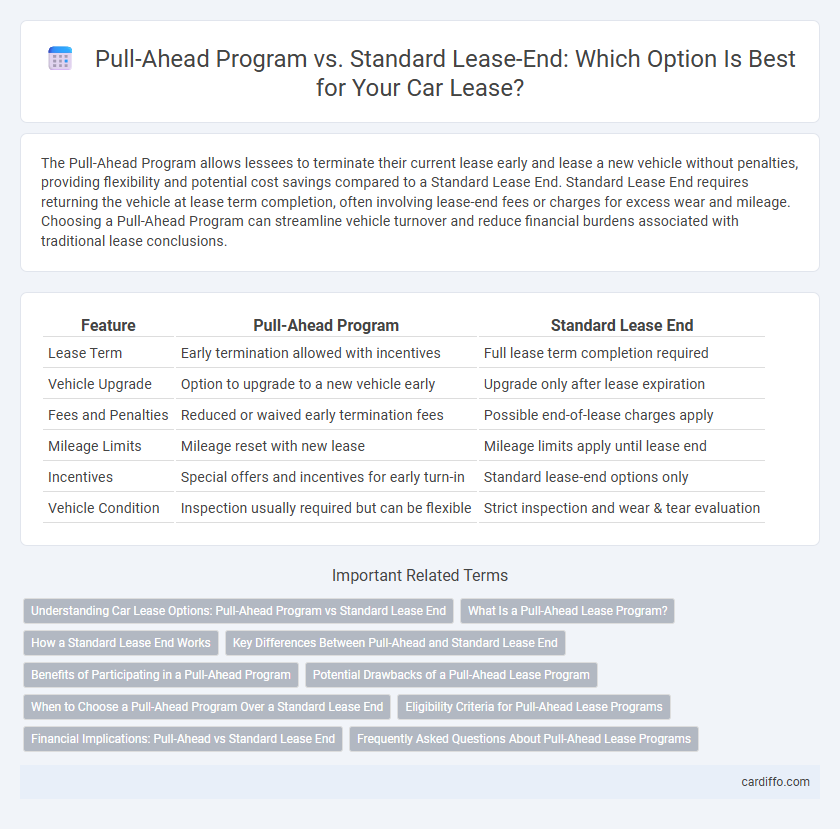The Pull-Ahead Program allows lessees to terminate their current lease early and lease a new vehicle without penalties, providing flexibility and potential cost savings compared to a Standard Lease End. Standard Lease End requires returning the vehicle at lease term completion, often involving lease-end fees or charges for excess wear and mileage. Choosing a Pull-Ahead Program can streamline vehicle turnover and reduce financial burdens associated with traditional lease conclusions.
Table of Comparison
| Feature | Pull-Ahead Program | Standard Lease End |
|---|---|---|
| Lease Term | Early termination allowed with incentives | Full lease term completion required |
| Vehicle Upgrade | Option to upgrade to a new vehicle early | Upgrade only after lease expiration |
| Fees and Penalties | Reduced or waived early termination fees | Possible end-of-lease charges apply |
| Mileage Limits | Mileage reset with new lease | Mileage limits apply until lease end |
| Incentives | Special offers and incentives for early turn-in | Standard lease-end options only |
| Vehicle Condition | Inspection usually required but can be flexible | Strict inspection and wear & tear evaluation |
Understanding Car Lease Options: Pull-Ahead Program vs Standard Lease End
A Pull-Ahead Program allows lessees to terminate their current lease early and lease a new vehicle from the same manufacturer without incurring penalties, often including incentives like waived fees or reduced payments. In contrast, a Standard Lease End requires returning the vehicle at lease maturity, with potential charges for excess mileage or wear and tear, and the option to purchase, renew, or lease a new vehicle afterward. Understanding these options helps consumers optimize costs and upgrade timing when managing car leases.
What Is a Pull-Ahead Lease Program?
A Pull-Ahead Lease Program allows lessees to terminate their current lease early and lease a new vehicle before the standard lease end date, often with incentives like waived fees or reduced payments. This program provides flexibility for customers seeking to upgrade or change vehicles without waiting for the lease to fully mature. It differs from a standard lease end, which requires returning the vehicle and settling all lease obligations at the agreed-upon term without early termination benefits.
How a Standard Lease End Works
A Standard Lease End requires the lessee to return the vehicle to the dealership without options to terminate early or upgrade before the lease term ends, often involving inspection for wear and mileage compliance. At lease conclusion, fees for excess mileage, damage, or disposition may be assessed, and the lessee must decide whether to purchase the vehicle, lease a new one, or walk away. This process contrasts with Pull-Ahead Programs that allow early lease termination and new vehicle acquisition with few or no penalties.
Key Differences Between Pull-Ahead and Standard Lease End
Pull-Ahead Program allows lessees to terminate their current lease early and start a new lease with reduced penalties or fees, offering flexibility and potential cost savings. Standard Lease End requires returning the vehicle at lease expiration, with possible excess mileage or wear charges applied based on the lease agreement. Key differences include timing flexibility, financial impact, and the opportunity to upgrade vehicles sooner with the Pull-Ahead option.
Benefits of Participating in a Pull-Ahead Program
Participating in a Pull-Ahead Program allows lease holders to upgrade their vehicle earlier without facing typical lease-end penalties or excess mileage fees. This program often provides incentives such as waived disposition fees and special lease rates on new vehicles, enhancing cost savings and convenience. The ability to transition seamlessly into a new lease helps maintain access to the latest technology and safety features while avoiding the hassle of lease-end negotiations.
Potential Drawbacks of a Pull-Ahead Lease Program
Pull-Ahead Lease Programs, while offering early upgrade opportunities, often involve higher monthly payments compared to Standard Lease End options. These programs can include additional fees or penalties that increase the total cost of leasing, reducing overall savings. Early lease termination may also affect credit scores and limit flexibility in choosing future vehicle options.
When to Choose a Pull-Ahead Program Over a Standard Lease End
Choosing a Pull-Ahead Program over a Standard Lease End is ideal when vehicle wear exceeds typical usage or when early upgrade incentives offset potential lease penalties. This option benefits lessees aiming to avoid excess mileage charges or costly maintenance as lease expiration nears. Pull-Ahead Programs offer flexible transition benefits, making them preferable in fluctuating financial or vehicle condition scenarios.
Eligibility Criteria for Pull-Ahead Lease Programs
Pull-Ahead Lease Programs typically require the lessee to have an active lease with a reputable manufacturer or dealership and often mandate that the lease be within a specific time frame, such as the last six months of the contract. Creditworthiness is a critical eligibility criterion, with many programs requiring a minimum credit score or a clean payment history on the current lease. Vehicle condition and mileage compliance may also be evaluated to ensure eligibility for early lease termination and renewal benefits under Pull-Ahead offers.
Financial Implications: Pull-Ahead vs Standard Lease End
Pull-Ahead programs often reduce financial burdens by allowing lease termination before the contractual end date, minimizing penalties and excess mileage charges compared to standard lease endings. Standard Lease End typically requires payment of lease-end fees, potential disposition charges, and costs for wear-and-tear repairs, which increase the total financial obligation. Choosing a Pull-Ahead option can lead to lower out-of-pocket expenses and more flexibility for upgrading to a new vehicle without incurring additional lease-end penalties.
Frequently Asked Questions About Pull-Ahead Lease Programs
Pull-Ahead Lease Programs allow lessees to return their vehicle before the lease term ends, often waiving early termination fees and enabling early upgrade to a new lease. Standard Lease End requires lessees to complete the full lease term and then return the vehicle or purchase it, typically involving standard end-of-lease fees and inspection processes. Common FAQs include eligibility criteria, potential financial benefits, and how mileage allowances are managed under pull-ahead offers.
Pull-Ahead Program vs Standard Lease End Infographic

 cardiffo.com
cardiffo.com